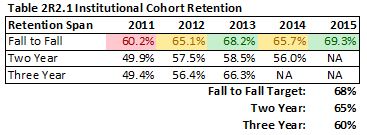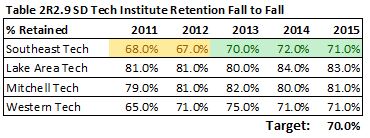2R2 Retention, Persistence, and Completion Results
What are the results for student retention, persistence, and completion?
• Summary results of measures (include tables and figures when possible)
• Comparison of results with internal targets and external benchmarks
• Interpretation of results and insights gained
Color Coding: Green: data point meets/exceeds target; Yellow: data point within 90% of target; Red: data point below 90% of target.
Summary Results of Measures with Internal Targets, Interpretation, and Insights Gained
Southeast Tech has a long history of calculating and analyzing Institutional cohort retention and graduation rates and using the data for continuous improvement, dating back to the 1990’s. This has provided the Institute with great opportunities to improve its programs, services, and operations to better meet student needs and retain them to completion. While the Institute tracks cohort retention/graduation rates over a three year period (fall-to-fall, two year, and three year), and sets targets for all three as indicated in Table 2R2.1, the Institute emphasizes its fall-to-fall retention target because it provides the most immediate feedback regarding retention/graduation trends and can lead the Institute to more immediate improvement opportunities. The Southeast Tech Board and Council has set a target of 68% for fall-to-fall retention. Based on previous retention rates, the target was set because it provided the Institute with a meaningful and achievable goal. As indicated in Table 2R2.1, Southeast Tech has seen an increase in student fall-to-fall retention from 60.2% (2011) to 69.3% (2015), the highest retention rate for the Institute and meeting the Institute’s target for the second time. The Institute believes that the solid focus placed on student retention, and the various action projects implemented from 2009 on, have played a key role in these improvements (2P 1 ).
While Southeast Tech uses these retention rates for continuous improvement across the campus, the results are also disaggregated by program and shared with academic administrators and program faculty each fall for continuous improvement at the program level (2P 1 ).
Perkins data is reported annually to the state Department of Education (DOE) and includes two measures related to student retention. The first measure (Table 2R2.2) monitors the combined retention-transfer rates based on a student cohort defined by the federal Perkins administration and DOE. The low target level is set by an agreement between Perkins and the state. The Institute has exceeded this target easily over the past few years and has seen a positive increase in overall retention rates in 2013 and 2014 when compared to the previous two years. 
The second measure (Table 2R2.3) provides completion data for students receiving credentials, certificates, or degrees. While the data shows a significant decrease in percentage from 2012 to 2014, it is partially due to a change in the cohort creation requirements, which lowered the number of completed credits from 24 to 12 to be included in the cohort. Southeast Tech’s current results are just slightly below the established target. At this point, Southeast Tech will continue to monitor the results to determine if any actions are necessary.
Note: Perkins data is not currently available for the 2015 cohort.
Comparison Results with External Benchmarks, Interpretation, and Insights Gained
IPEDS data allows the Institute to benchmark its graduation rates against national two-year college mean rates. The IPEDS 150% graduation rate bases the calculation on established first-time, full-time cohorts who have been given 150% of expected time to graduation to become completers (three years for a two-year program). Many Southeast Tech students who are new to the college experience require additional time to complete their program. Therefore, Southeast Tech chose this calculation because it provides the Institute with a measure that allows for this additional time yet still meets the mission of getting graduates into employment as soon as possible. Because Southeast Tech has another comparison measure that directly relates the Institute’s retention rates to the state’s other three technical institutes, Southeast Tech uses the national rate for comparison here rather than establishing a subgroup. As Table 2R2.4 indicates, Southeast Tech’s graduation rate has improved 10% over the past five me asurses and has been at or above the IPEDS mean score every year. Southeast Tech had set an initial target of 34%; however, with the solid results it has seen, the Institute will be reviewing and adjusting this target for the 2017-2018 year. asurses and has been at or above the IPEDS mean score every year. Southeast Tech had set an initial target of 34%; however, with the solid results it has seen, the Institute will be reviewing and adjusting this target for the 2017-2018 year.
NCCBP data provides opportunities for the Institute to benchmark Next-Term and Fall-to-Fall Persistence rates as well as Pass Rates in College-Level Coursework. (As noted in 2R 1 , NCCBP data lags due to data collection and distribution and will not be updated again until summer 2017.) In all three of these areas, as indicated in the three NCCBP charts, Southeast Tech’s percentile ranking has remained high. 
Next-Term persistence (Table 2R2.5) measures the percentage of students who persist from the cohort’s initial semester to the following semester. The Institute’s 84.5% for the 2013 cohort currently ranks at the 97th percentile. The annual percentages have also remained fairly consistent over the past five measures. Fall-to-Fall persistence (Table 2R2.6) measures the percentage of students who persist to the following fall semester, and the Institute’s 58.8% for the 2013 cohort currently ranks at the 93rd percentile. Additionally, the persistence percentage level has been on an upward trend over the past five measures. Finally, the Institute’s Enrollees Passing College-Level Courses (Table 2R2.7) is at 79.8% for the 2013 cohort, which currently ranks at the 77th percentile. The past two measures for these pass rates have also been the highest recorded by the Institute thus far.
Targets for the three NCCBP measures are set by the Student Success Team and provide another opportunity for continuous improvement. The Team is pleased with these results and is not currently pursuing any process adjustments based on these results.
NSC is a new comparison data measure (Table 2R2.8). Currently, the Institute is using the data to measure and benchmark outcomes over long timeframes (6 years). As more of this data becomes available, the Institute will be able to gauge and review trend data as well as set more meaningful targets. However, at the current time, the Student Success Team has set an initial overall target of 60%, which is slightly above the initial data point. 
State Reports for Technical Institutes provide the Institute with one more opportunity for benchmarking. South Dakota has four technical institutes with Southeast Tech the largest of the three and located in the largest urban area in the state. As part of the state’s annual reporting requirements, all technical institutes provide the state with fall-to-fall retention rates (Table 2R2.9).
Although the data is valuable, direct comparison and analysis is difficult. For example, Southeast Tech has the highest percentage of part time students, a student group that has a higher percentage of attrition (Table 2R2.10), as well as one of the highest percentages  of ethnic minority and non-traditional by age student populations. Southeast Tech is also located in a highly competitive higher education region with nine other post-secondary choices in the immediate area or within driving distance. The region currently has a less than 3% unemployment rate, making employment opportunities a chief competitor for the Institute’s students. of ethnic minority and non-traditional by age student populations. Southeast Tech is also located in a highly competitive higher education region with nine other post-secondary choices in the immediate area or within driving distance. The region currently has a less than 3% unemployment rate, making employment opportunities a chief competitor for the Institute’s students.
However, the Institute’s Student Success Team established a 70% target level prior to 2012 because the Institute had never attained this level, but the Team believed it was in reach. That level has now been achieved for the past three measures (2103, 2014 and 2015). During its summer 2017 retreat, the Student Success Team will re-evaluate the target to determine a new stretch goal.
Overall Interpretation of Results and Insights Gained
Overall Southeast Tech retention rates, whether analyzing those tracked for internal purposes, benchmarking purposes, or for federal and state funding, have been very positive and moving in an upward trend. The Institute believes that the actions it has taken in recent years has played a significant role in improving these rates. At this point, the Institute will continue to focus its attention on the retention rates and actions associated with its key student groups (2P1) (2R1), which in turn will significantly improve the results listed here.
Add to Catalog Bookmarks (opens a new window)
|